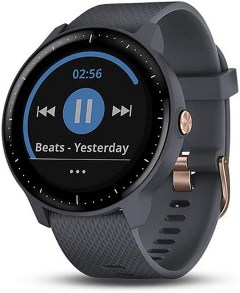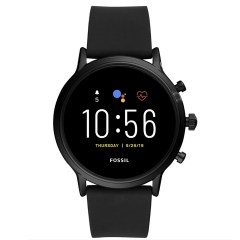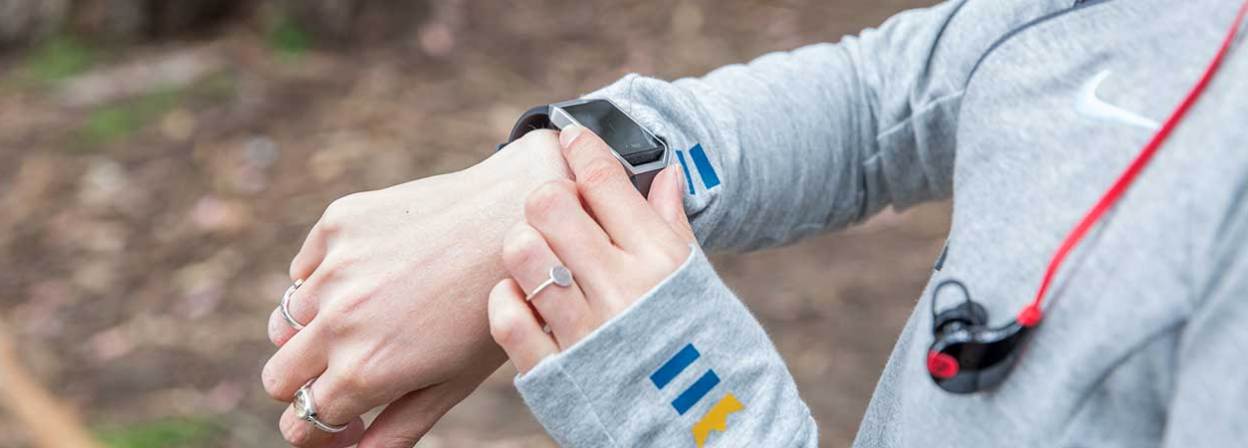BestReviews is reader-supported and may earn an affiliate commission. Details

Fitness-focused Samsung smartwatch that looks great and holds its charge for days. High-quality product.
Three color options that all coordinate well with most outfits. Wireless charger. Works with Android and iOS. Can easily change the bands for different colors and sizes. One-year warranty. Water-resistant and durable. Multiple colorways available.
Reported issues with software and possible step inaccuracies.

A more fitness-centered and affordable Android-compatible smartwatch that excels with its 4+ day battery life, swim-proof activity tracking, high-resolution screen, and ability to store over 300 songs.
Wirelessly syncs with Android devices. Receives call, text, calendar, and smartphone notifications. Available in a wide assortment of colors and bands. Automatically tracks stats from your activity and workouts. Water resistant.
Although you will get in-app notifications of calls, texts, etc., you can’t directly reply to them via the Versa.

An excellent choice for anyone who needs a dependable smartwatch to accurately track their fitness regimen, as well as a convenient way to bring along 500 of their favorite workout tunes to the gym and beyond.
Respond to texts from Android devices. Download up to 500 songs. Customizable watch faces. Impressive 7-day battery life in smartwatch mode. Includes Garmin Pay. Features 15 different sports tracking apps. 6 colors available.
Spotify, iHeart Radio, and Deezer are the only music platforms currently compatible with this smartwatch.

While battery life could be better, this option offers high-caliber fitness capabilities and a wide range of personalization options.
Features premium fitness tracking, including GPS and sensors to monitor and track heart rate and sleep. Swim-proof. Thousands of watch faces and hundreds of apps to choose from. Can be used with Android and iOS. 8GB of storage. Includes an NFC pay feature. Charges in under an hour.
Short battery life is a common complaint with this smartwatch.

While buyers have had issues with some of the installed fitness apps, this is one of the better sub-$100 smartwatches.
Fitness tracking capabilities include a wide range of apps and sensors. Eight exercise modes in all, covering sports from swimming to badminton. Five brightness levels. Charges in two hours and runs for seven days with typical use. Waterproof and lightweight.
Some reports of fitness apps and sensors not correctly tracking progress or returning inaccurate readings.

We recommend these products based on an intensive research process that's designed to cut through the noise and find the top products in this space. Guided by experts, we spend hours looking into the factors that matter, to bring you these selections.

When they first appeared on the tech scene, smartwatches were little more than a novelty item. Big, uncomfortable, and sporting few features, they were more of a sci-fi movie prop than a valuable organizational tool.
Fast forward to today. Smartwatches on the market now are full-featured and stylish. They can do everything from keep you up to date on texts, calls, and social media accounts to stream music and track every aspect of your fitness regimen. Paired with your Android phone or mobile network, they have become an indispensable tool designed to keep you informed, fit, and organized.
From networking and OS compatibility to battery life and the variety of apps available, this guide covers everything you need to know to purchase a smartwatch for your Android phone. In addition to covering what you can expect at various price points, we also share a variety of our favorite Android-capable smartwatches and highlight why we recommend them.

One of the first uses of the smartwatch was as a fitness tracker, and this is still a priority feature in most of these watches.
Today, smartwatches include a range of apps and sensors that can perform a wide variety of functions, including track fitness progress, monitor vital signs, count calories, and even design workouts tailored to interests and needs. More advanced versions of these watches include GPS for mapping cycling or running routes and offer more specialized monitoring, such as tracking blood oxygen levels.
Whether you’re counting steps or training for a marathon, there’s a smartwatch to help you reach your goals. Be sure that any smartwatch you’re considering will work with the necessary apps and has the sensors needed to meet your fitness needs.
Pretty much all smartwatches include Bluetooth, so they will work with your smartphone. Some also include long-term evolution (LTE), so you can network the smartwatch without a phone.
Some smartwatches only notify you when you receive something like a text or call, allowing you to decide if you need to immediately deal with it via your smartphone. Other smartwatches let you respond to texts, email, and calls using the watch. Note that all smartwatches should let you decide what notifications the watch receives and how you’re notified (screen prompt, audible beep, or vibration).
Because much of a smartwatch’s functionality relies on its pairing with a smartphone, you should verify that any smartwatch you’re considering actually works with your phone. Be sure that the smartwatch not only works with your particular OS (in this case, Android) but also the OS version. This is particularly true if you have an older smartphone, which might only work with older Android OS versions.
Another primary consideration with smartwatches is how long you can wear one before having to recharge it. Smartwatches contain a rechargeable battery, which can last anywhere from 24 hours to a week, depending on the watch. A watch with a longer battery life offers much more convenience than a watch that you need to recharge every day.
Recharging method: The way you recharge the battery also varies from smartwatch to smartwatch. Some use a cord or dock to charge them, requiring you to keep track of yet another cord or even take the watch apart to charge it. Other smartwatches use a much more user-friendly wireless charging method; all you need to do is lay the watch on something like a charging puck to top off the battery.
Recharging time: You should also note how long it takes to completely recharge the smartwatch because this process can take anywhere from less than an hour to several hours. The longer the charging time, the longer you have to wait before you can use your smartwatch.
Because you wear your smartwatch out in the world, it should be rugged enough to handle whatever the world throws at it. A stainless steel case and strengthened glass really help here. All smartwatches have some level of water resistance, some to the point that you can wear them while swimming. But before you dive into the pool wearing your smartwatch, be sure you know exactly how waterproof it is.
Smartwatches typically have some form of near-field communication (NFC) built into them, which you can use to quickly and easily pay for items at the register, no wallet needed!

Smartwatches come with a variety of pre-installed apps and are compatible with hundreds or even thousands more that you can download and install. A large number of popular Android apps, such as Google Maps, Uber, and Tinder, in addition to music and gaming apps, are available for use on these smartwatches. When buying a smartwatch, know what apps it comes with and what apps are available for use with the watch.
While less important than other types of computerized devices, such as smartphones and laptops, the amount of storage a smartwatch has is still a consideration. Internal storage can be used for apps, photos, streaming media, and other information. Current smartwatches usually have around 4 gigabytes of storage, although some have as much as 16.
The two primary ways of interacting with a smartwatch are through the display and through controls.
Display: Most smartwatch displays are LCD, although some pricier models use OLED or AMOLED displays that are thinner and provide richer colors. Color displays provide you with a better visual experience but also drain the battery more quickly than black-and-white displays. Smartwatches usually have a touchscreen, which you use by either tapping or swiping.
Controls: In addition to the display, many smartwatches include controls on the side of the case that can be used for tasks like scrolling through windows or menus. These are usually in the form of buttons or bezels that rotate.
In the past few years, smartwatch style has improved considerably to the point where these watches are as small and stylish as traditional watches. Indeed, some even resemble traditional watches right down to the round cases. Some smartwatches are more utilitarian; others are more stylish. Some are available in a variety of colors and styles, while others let you swap out elements like the watchband when you order. Give some thought to how important the appearance of the smartwatch is to you before purchasing one.

Inexpensive: Smartwatches in the $25 to $100 range usually have less powerful batteries, fewer apps, and simple notifications through your Android phone via Bluetooth. If you’re in search of a simple smartwatch to keep track of steps and smartphone notifications, this range probably meets your needs.
Mid-range: In the $100 to $200 range, you can find smartwatches with more storage (4 to 8 gigabytes) and improved fitness apps and sensors. Smartwatches in this range are still largely notification only, with some offering limited response/reply capabilities. Shop in this range if you want a smartwatch with better water resistance, a more robust app selection, and longer battery life.
Expensive: For the latest smartwatch, target those in the $200 to $300 range. Serious athletes can find a wealth of fitness apps here, including sensors to measure and track everything from heart rate to blood oxygen levels. Advanced features like GPS, NFC, and LTE are common here, as are app collections that number in the thousands. These smartwatches tend to be thinner, more stylish, and require charging less often. You can use many of these smartwatches to text, call, or email without needing a phone.


A. Near-field communication is a technology that allows you to use your smartwatch to pay for purchases at the register. Once you’ve stored your credit or debit card information in the smartwatch, you can pay for items without the need to carry your cards with you. Many smartwatch manufacturers and OS makers have their own NFC pay system, including Samsung Pay, Garmin Pay, and Google Pay.
A. That largely depends on the brand of smartwatch you buy, although most of them work with both Android and iOS. There might be some differences when using them with the two operating systems, either in terms of functionality (some features may work for Android but not iOS, for example) or apps that are OS-specific. You might also need to download and install an app to the smartwatch so that it can recognize and work with iOS. Read the smartwatch listing carefully (or contact the seller or manufacturer) to verify that it will work with the operating system you want it to.
A. Most smartwatches include Bluetooth. This allows you to pair the watch with your smartphone and do everything from stream music to be notified when you receive a text, call, or email (or even respond to them with some smartwatches).
With long-term evolution (LTE), you don’t need to be anywhere near your phone to use some of these advanced features. LTE allows you to connect your watch directly to a mobile network, so you don’t need to go through a phone to receive texts or stream music. While this is a great feature for some people, there are a number of caveats to consider before you pay extra for LTE. One of the biggest is it costs more. You’ll pay more for a smartwatch that is LTE capable and pay an added monthly surcharge (usually around $10 per month). Add to this the fact that connection quality can be iffy with LTE and that LTE uses much more power than Bluetooth, and you might decide that carrying your phone to use with your smartwatch is the better option.
Get emails you’ll love.
Learn about the products you’re wondering if you should buy and get advice on using your latest purchases.
